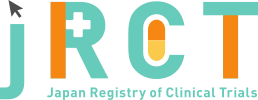臨床研究等提出・公開システム
|
Feb. 20, 2019 |
|
|
May. 31, 2022 |
|
|
jRCTs061180025 |
An observational study for incidence of thromboembolism in lung cancer patients, and the evaluation for efficacy and safety of edoxaban in active cancer patients with venous thromboembolism. (Rising-VTE study) |
|
An observational study for incidence of thromboembolism in lung cancer patients. (Rising-VTE study) |
|
Aug. 12, 2020 |
|
1021 |
|
The median age was 70 years with 70.8% being males. 63.6% of patients had adenocarcinoma, and 13.6% had small cell lung cancer. More than 90% of the enrolled patients received chemotherapy including TKI and ICI. At the time of diagnosis of lung cancer, 62 patients had VTE. |
|
A total of 1021 patients were enrolled from June 2016 to August 2018. 1017 patients met the eligibility criteria and 4 patients did not meet the eligibility criteria. 13 patient was eliminated because of protocol violation. |
|
There were 100 adverse events and 32 Grade 3 or higher adverse events. The most common adverse events in all grades were neutropenia in 7 cases, leukopenia in 6 cases, and leukopenia in 6 cases. No related deaths were observed with edoxaban treatment. In addition, adverse events with urgent obligations were reported to the Safety Evaluation Committee, and the results judged to require attention were made known to the participating facilities. |
|
Sixty-two patients had VTE at the time of the lung cancer diagnosis, and 38 patients developed VTE were observed on the follow up after 2 years, making a total of 100 patients. Of these diagnosed patients, 55% had DVT, and only 26% of these patients presented with symptoms at VTE diagnosis. No cases of VTE recurrence were found 6 months and 2 years after the start of treatment with edoxaban. Major and clinical relevant nonmajor bleeding related to edoxaban occurred in 4.9% and increased to 22.7% in the edoxaban treatment group in 6 months. No treatment related deaths due to bleeding were observed in all registered patients. The two-year survival probability rate was 0.43 in the non-VTE group and 0.48 in the VTE with edoxaban treatment group, showing no statistical difference. |
|
we conclude attention should be paid to VTE during treatment for lung cancer. Second, treatment with edoxaban was highly effective in preventing recurrence of VTE, but treatment should be considered more carefully because of the high bleeding possibility. |
|
May. 31, 2022 |
|
July. 21, 2022 |
|
https://journals.sagepub.com/doi/pdf/10.1177/17588359221110171 |
No |
|
No plan |
|
https://jrct.mhlw.go.jp/latest-detail/jRCTs061180025 |
ISOBE Takeshi |
||
Shimane University Hospital |
||
89-1, Enya-cho, Izumo-shi, Shimane |
||
+81-853-20-2578 |
||
isobeti@med.shimane-u.ac.jp |
||
TSUBATA Yukari |
||
Shimane University Hospital |
||
89-1, Enya-cho, Izumo-shi, Shimane |
||
+81-853-20-2578 |
||
ytsubata@med.shimane-u.ac.jp |
Complete |
June. 01, 2016 |
||
| June. 02, 2016 | ||
| 1000 | ||
Interventional |
||
single arm study |
||
open(masking not used) |
||
uncontrolled control |
||
single assignment |
||
treatment purpose |
||
1)Pathologically or cytologically diagnosed non-small-cell or small cell lung cancer. |
||
1)History of allergic reaction for edoxavan. |
||
| 20age old over | ||
| No limit | ||
Both |
||
Non-small cell lung cancer, small cell lung cancer |
||
edoxaban 60 or 30mg/day for 6 months |
||
VTE noncompliant group (observation group): Symptomatic VTE incidence rate in 2 years after this study registration. |
||
VTE noncompliant group (observation group): The incidence of asymptomatic VTE incidence and symptomatic / asymptomatic arterial thrombosis 2 years after this study registration, the incidence rate of bleeding events in 2 years after this study registration, The incidence of hemorrhagic events during the 6 months after the study registration, the symptomatic VTE incidence rate for 6 months after the study registration, the overall survival time. |
||
| Daiichi Sankyo Company, Limited | |
| Not applicable |
| Daiichi Sankyo Company, Limited | |
| Not applicable |
| Shimane University Hospital Clinical Trial Review Board | |
| 89-1, Enya-cho, Izumo-shi, Shimane | |
+81-853-20-2515 |
|
| kenkyu@med.shimane-u.ac.jp | |
| Approval | |
Nov. 26, 2018 |
| UMIN000020194 | |
| University hospital Medical Information Network (UMIN) |
None |
